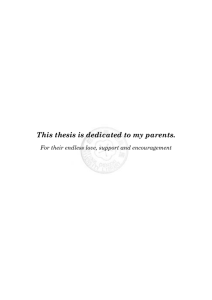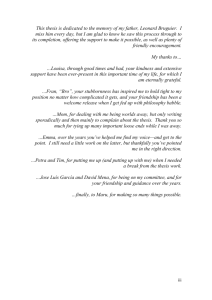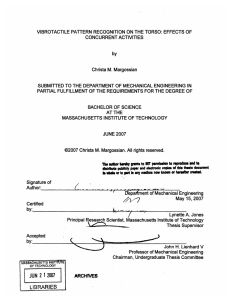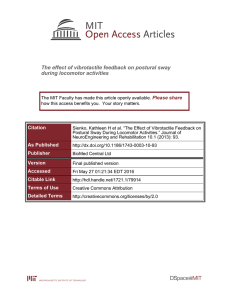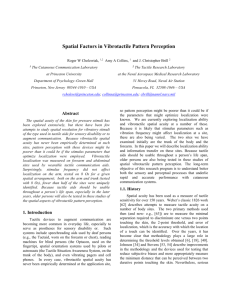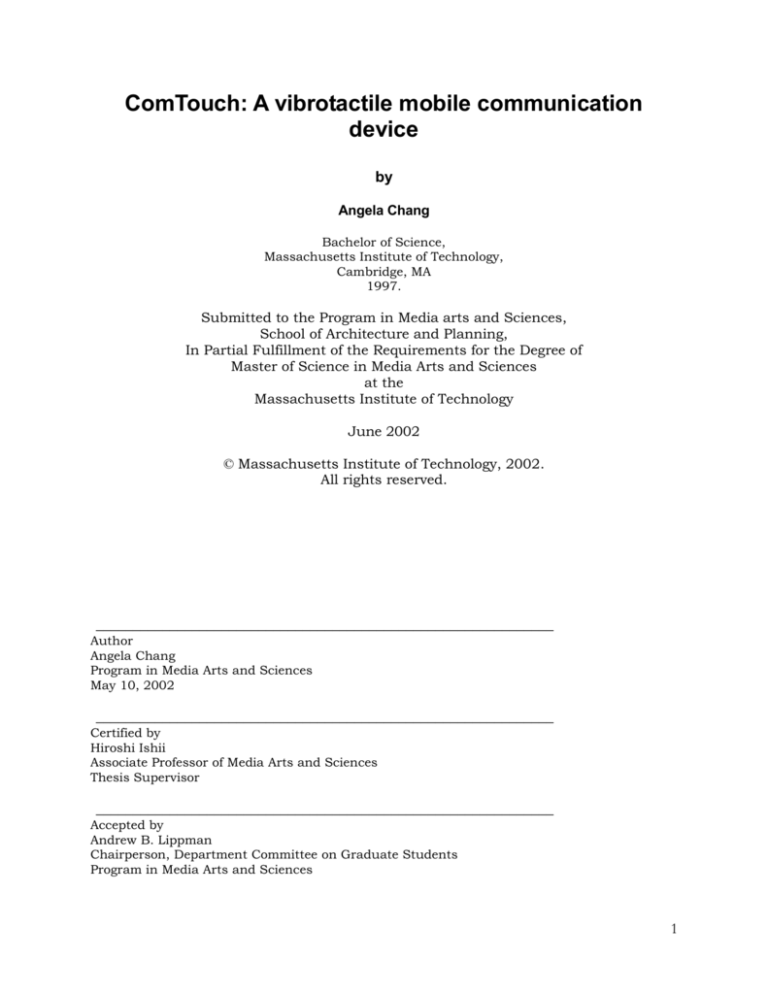
ComTouch: A vibrotactile mobile communication
device
by
Angela Chang
Bachelor of Science,
Massachusetts Institute of Technology,
Cambridge, MA
1997.
Submitted to the Program in Media arts and Sciences,
School of Architecture and Planning,
In Partial Fulfillment of the Requirements for the Degree of
Master of Science in Media Arts and Sciences
at the
Massachusetts Institute of Technology
June 2002
© Massachusetts Institute of Technology, 2002.
All rights reserved.
______________________________________________________________
Author
Angela Chang
Program in Media Arts and Sciences
May 10, 2002
______________________________________________________________
Certified by
Hiroshi Ishii
Associate Professor of Media Arts and Sciences
Thesis Supervisor
______________________________________________________________
Accepted by
Andrew B. Lippman
Chairperson, Department Committee on Graduate Students
Program in Media Arts and Sciences
1
ComTouch:
A vibrotactile mobile communication device
Angela Chang
Submitted to the Program in Media Arts and Sciences,
School of Architecture and Planning, on May 10, 2002
in Partial Fulfillment of the Requirements for the Degree of
Master of Science in Media Arts and Sciences at the
Massachusetts Institute of Technology
Abstract
This thesis presents ComTouch, a new device for enhancing interpersonal
communication over distance through use of touch. The ComTouch approach
investigates how the sense of touch can be remotely represented by means of a
vibrotactile, or touch-and-vibration, interface. Touch has potential to improve existing
remote communication by allowing tactile cues to augment the audio-visual
information in real-time.
The approach of ComTouch is to use this vibrotactile mapping for conveying the
pressure exerted by each finger of the transmitter as patterns of vibration against the
corresponding finger of the receiver. The implementation is a hand-held device that
allows a user to transmit and receive patterns of vibration to and from a remote user.
A pair of prototypes are built to allow exploration of remote communication using this
vibrotactile mapping.
The hypothesis is that the vibrotactile mapping can be used in remote communication
of tactile gestures, or expressive uses of touch. User studies will be performed to gauge
the information content of the signals transmitted and received using the vibrotactile
device in remote communication. A report of the observed usages of the vibrotactile
channel will be given. This research will allow us to identify patterns of tactile
communication that may inform the design of new tactile communication devices,
languages and methods.
Thesis Supervisor:
Hiroshi Ishii
Associate Professor of Media Arts and Sciences
Thesis Committee
2
_______________________________________________________
Thesis Supervisor
Hiroshi Ishii
Associate Professor of Media Arts and Sciences
Massachusetts Institute of Technology
_______________________________________________________
Thesis Reader
Sile O’Modhrain
Principal Research Scientist, Palpable Machines
Media Lab Europe
_______________________________________________________
Thesis Reader
Robert Jacob
Associate Professor of Electrical Engineering and Computer Science
Tufts University
Acknowledgments
The author wishes to express sincere appreciation to Professors Hiroshi Ishii, Sile O’Modhrain
and Robert Jacob for their assistance in the preparation of this manuscript. Thank you for your
patience and willingness to see me through this undertaking.
I would like to give special thanks to Eric Gunther whose familiarity with vibrotactile actuation
was helpful during the design phase. Without the generous donation of time, equipment and
advice from Dave Franklin of Audiologic Engineering, this work would not have been possible.
The author thanks her undergraduate research assistants: Zahra Kanji, for her dedication, Flora
Chiu for her willingness to learn new tools for PCB fabrication, Matthew Malcolm for his skilled
hand in the repair of electronics, and Kenji Alt for his help in observational prototyping.
I was lucky enough to work with those whose wisdom and work ethic inspire me. Attitude is the
key of success, and Kenroy Cayetano was there to help me think through the technical issues of
the circuit design. Jennifer Yoon, whose quality videos made the presentations successful. Ian
Gouldstone, for his artistic visual guidance, critiques, timely work, and professional animations.
3
In addition, the members of the Tangible Media Group are acknowledged for their valuable input
and feedback. The current group members James Patten, Gian Pangaro, Dan Maynes-Aminzade,
and Brygg Ullmer contributed much camaraderie in this research.
The alumni of the Tangible Media Group were also of great help. I would like to thank Victor Su,
for his remote help in designing the system, Andrew Dahley for his evaluation and feedback, Phil
Frei, for his design advice and example, and Scott Brave for his experimental testing advice. Their
work on InTouch was inspirational. I would also like to thank Craig Wisneski, Sandia Ren, and
Ali Mazalek for their engineering advice and wise viewpoints, which saved me much time. Also,
past UROP Rujira Hongladaromp’s optimism helped with the existing debugging of inTouch.
The researchers at Media Lab Europe are thanked for their support and camaraderie.
Particularly, the folks at the Palpable machines lab, Andy Brady, Brian MacDonald, and Ian
Oakley were helpful in the understanding of the fabrication and experimental design problems I
faced.
The students of Slugfest, Fourth East, East Campus dormitory.
To my good friends Ela Ben-Ur and Arrin Katz, Rich Fletcher and Virginia Siu, Barbara Abreu
and Jackie Youngblood and my cousins, Raymond and Joyce, for visiting, emailing and calling.
To LCS/Telegraphics, specifically Robert Dezmelyk, for teaching me how to think about
technology. Howard Eglowstein, for teaching me how to design and build electronic devices to do
my bidding. John Jurewicz for imparting his thrill of technology, Sylvia Johnson-Phillips for her
systematic approach to management and Richard Poyner for showing me the importance of
technical documents and white papers.
I would like to thank Tom Hayes of the Harvard Extension School for his wisdom and hands-on
manner to working with electronics.
My parents, Matty and Enrique Chang, for allowing their daughter to go to school at such a
wonderful institution. Benjamin for his brotherly advice and encouragement.
James Edward Gouldstone, the inspiration and supporting force behind all that I do. Your
artistic ability helped me visualize ComTouch for the first time, and your guidance in the
mechanical design was the cornerstone of the work presented.
4






